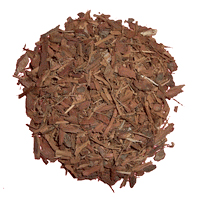White Oak Bark
for your information...

The scientific name for White Oak Bark is Quercus alba. White Oak Bark, as its name suggests, comes from the bark part of the plant. Another name for White Oak Bark is Tanner's Oak. You can use both the leaves and bark of the plant for medicinal purposes. Generally speaking, though, the inner white bark of the plant is best for use.
Interestingly enough, White Oak was vital in wooden ship construction for centuries, from the English ships made from the English Oaks that brought our forefathers to this continent to the gun deck of the famous frigate Constitution and to the keels of World War II minesweepers and patrol boats.
The North American colonists used the White Oak for barrel making because the wood when it gets wet, swells up, and seals the barrel. This enables it to hold liquids, including the all-important rum. Rum at that time represented our foreign trade. Unfortunately the slave trade was tied to rum. Rum, in its own rights, had some medicinal uses as well.
Medicinally, White Oak Bark is the classic example of an astringent. Due to its high calcium and tannins content, it acts by precipitating the tissue protein to tighten the tissues. It also acts as an antiseptic.
White Oak Bark is good for skin wounds, bee stings, burns, diarrhea, fevers and cold, bronchitis, nosebleed, poison ivy, and varicose veins. Hemorrhoids in fact, are said to be an internal version of varicose veins. Also, this particular herb is good for the teeth. It can even be used in enemas and douches.
For external use, one may boil or steam the bark and/or the leaves and apply them over the area needing treatment to relieve bruises, injuries, varicosities, swollen tissues and bleeding. This also helps strengthen the capillaries - a large factor in why this herb is so useful in curing hemorrhoids.
For internal use, the tea normalizes the liver, kidneys, and spleen, also is good for inward tumors and swellings.
Bodily Influences of White Oak Bark: Antiseptic, astringent, haemostatic, parasiticide, tonic.
- It's been used to treat diarrhea, dysentery and bleeding.
- Well known as one of the best remedies for piles and hemorrhoids, or any trouble in the rectum.
- In case of a loose tooth, it will help to strengthen the tissues and helps the tooth to set well in place.
- Reduces the deleterious effects of poisonous medicines, especially if ulceration of the bladder and bloody urine occurs.
- It's a strong astringent, and is used for both external and internal hemorrhage. It has a cleansing effect on inflamed surfaces of the skin or mucous membranes.
- The bark can be used for chronic diarrhea, chronic mucous discharges and passive hemorrhage.
- Very useful in goiter and hardened neck.
- White Oak Bark has been used to expel pinworms and in the cleansing of the entire gastrointestinal tract.
- Highly astringent qualities have made it very popular for use on varicose veins and hemorrhoids.
- Very helpful to prevent nocturnal emissions or night losses due to excessive sexual desire or a weakened condition.
- White Oak Bark has been known to stop bleeding in the stomach, liver, lungs and bowels. Increases the flow of urine and acts as a good antiseptic and astringent.
- Also known for stopping the spitting up of blood.
- Supports bladder and is used in douches and enemas.
- Used for external and internal bleeding.
- Healing of damaged tissues in the stomach and intestines.
- Used for excess mucus with common complaints such as sinus congestion and post-nasal drip.
- Increases the flow of urine.
- Removes kidney stones and gallstones.
- Brings down fever temperature.
- White Oak Bark relieves the stomach by toning it for better internal absorption and secretion, improving metabolism.
General Uses For White Oak Bark At A Glance:
- Bladder infections
- Ulcerated bleeding (internal & external)
- Stomach
- Liver
- Bowels
- Bruises
- Cancer
- Canker sores
- Dental problems
- Diarrhea
- Enemas
- Fevers
- Gallstones
- Gangrene
- Gingivitis
- Glandular swellings
- Goiter
- Gums (bleeding & sore)
- Hemorrhage
- Hemorrhoids
- Indigestion
- Insect bites
- Jaundice
- Kidney problems
- Kidney stones
- Liver problems
- Menstrual problems
- Mouth gargle
- Mouth sores
- Nausea
- Prostate Problems
- Skin diseases
- Skin irritations
- Snake bites
- Sores
- Spleen problems
- Loose teeth
- Toothaches
- Strep throat
- Tumors
- Ulcers
- Urinary problems
- Uterus (prolapsed Vaginal discharge
- Varicose veins
- Vomiting
- Worms
Phytochemical Content: (Plant derived chemical compounds…in other words, these are what the herb plant is made up of.)
Beta-carotene, beta-sitosterol, catechin, gallic acid, pectin, quercetin, quercitrin, tannin.
Sources of Information:
- Balch, James F., M.D. and Balch, Phyllis A., CNC. Prescription for Nutritional Healing. Penguin Putnam Inc., 2000
- Ritchason, Jack N.D. The Little Herb Encyclopedia. Woodland Publishing Inc., 1995.
- Kloss, Jethro. Back to Eden. Beneficial Books, 1972.

